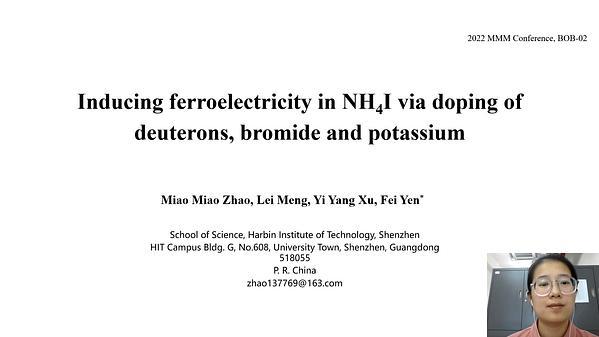Would you like to see your presentation here, made available to a global audience of researchers?
Add your own presentation or have us affordably record your next conference.
The need to measure high-frequency magnetic permeability has increased due to the 5th generation mobile communication system. We developed a microstrip line-type
probe and demonstrated comprehensive bandwidth permeability measurement up to 67 GHz 1. For the permeability measurement of the thick magnetic sample, the demagnetizing effect
caused the measurement error and the shift of the ferromagnetic resonance (FMR) 2-3. In this study, a microstrip conductor with slits has been developed to enhance the current
uniformity and reduce the demagnetizing effect in the thick magnetic material, as shown in Fig. 1 (a). This in-plane excitation decreased the demagnetizing effect. Fig. 1(b) shows the
photograph of the microstrip line type probe with slits. The probe consists of a microstrip conductor (1.3 mm in total width) on a glass substrate and a ground plane. The 15 μm wide copper
conductors (2 μm in thickness) and 15 μm wide gap were fabricated by lift-off process and rf sputtering. Also, the SMA connectors were connected with both input and output terminals.
First, S21 is calibrated by applying a strong DC field (2 T) in the vertical direction of the high-frequency field to saturate the sample. Secondly, S21 is measured without a strong DC field.
The complex permeability was optimized by the complex impedance and FEM analysis 2. Fig. 2 shows the relative permeability of the NiZn ferrite sheet (3 mm x 1 mm, 100 μm thick).
Measured permeability agreed well with the value of the Nicolson-Ross-Weir method 4. The measurement point was 201 from 0.1 GHz to 20 GHz. 96% of the whole real part was within
±15%, and 92% of the entire imaginary part was within ±15%. We have demonstrated that this microstrip line type probe with slits can accurately evaluate thick magnetic material because
the uniform current inside the microstrip conductor prevents the measurement error caused by the demagnetizing effect.
References:
1S. Yabukami et. al., IEEE Transactions on Magnetics, Vol. 57, No. 2, 6100405 (2021).
2S. Yabukami et al., IEEE Transactions on Magnetics, vol. 58, No. 2, 6100305 (2022).
3K. Takagi et. al., Journal of Magnetic of Japan, vol. 46 (2022, in press).
4A. M. Nicolson et. al., Transactions on Instrumentation and Measurement, vol. 19, no. 4, pp. 377-382 (1970).

